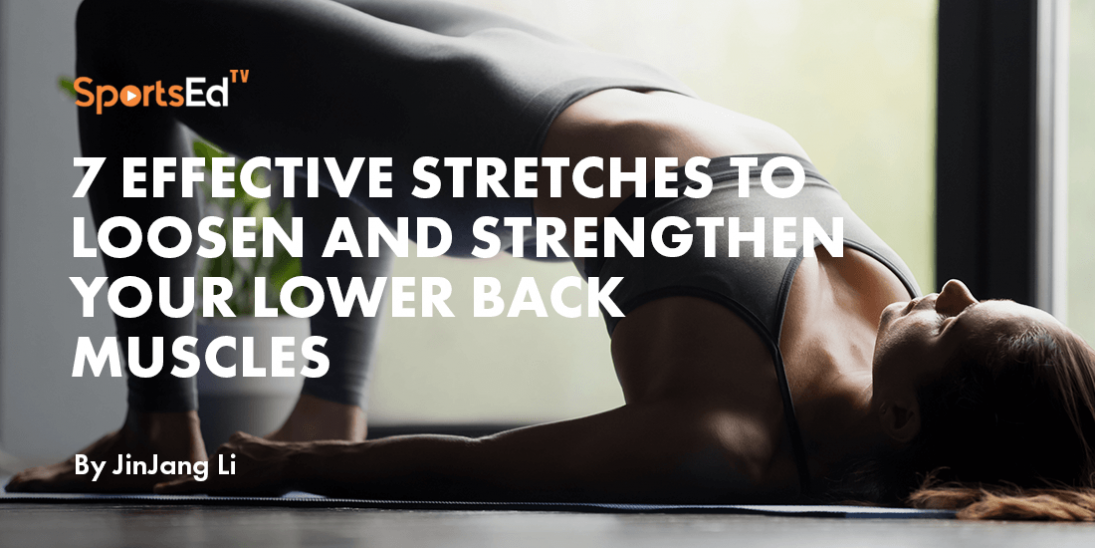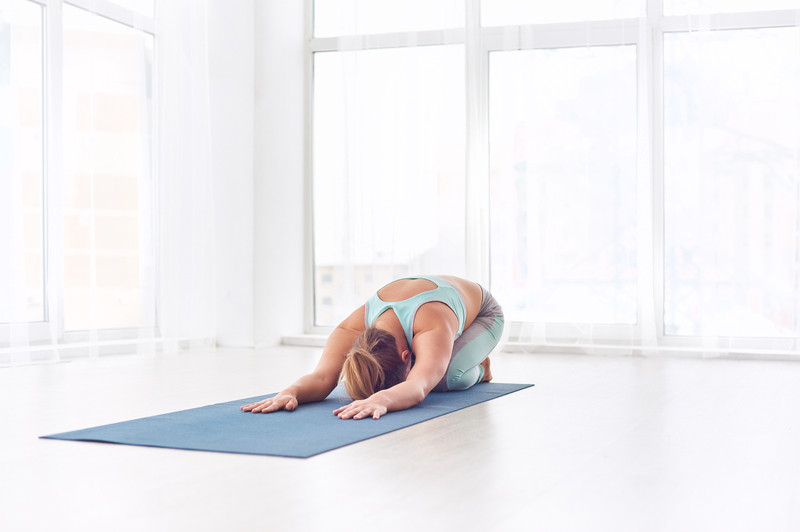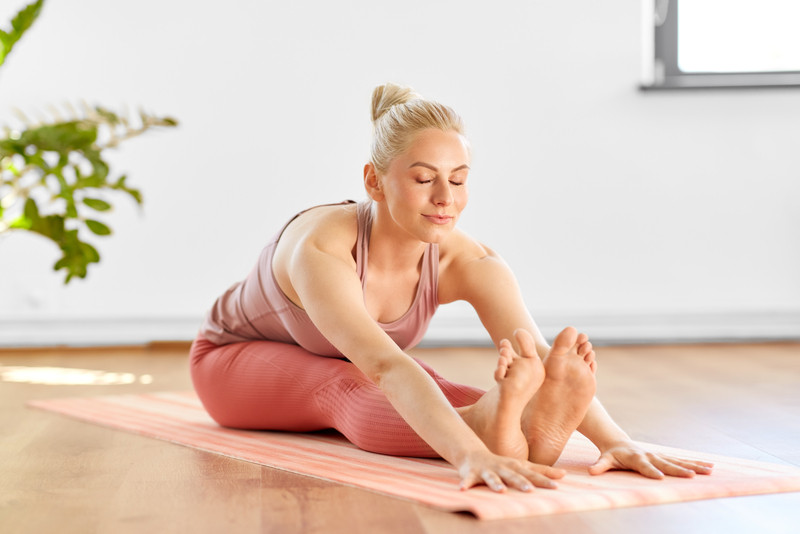Strength And Conditioning, Stretching
Welcome and thanks for visiting...

7 Effective Stretches to Loosen and Strengthen Your Lower Back Muscles

Are you tired of dealing with nagging lower back pain? You're not alone. Whether it's from sitting for extended periods or engaging in strenuous physical activities, lower back pain can become a persistent issue that affects your everyday life. But don't worry; relief may be closer than you think. This article will explore seven effective stretches that can help loosen and strengthen your lower back muscles, providing you with the relief you need. These stretches target the major muscles in your lower back, including the erector spinae and the glutes, while also promoting flexibility and mobility. From the classic child's pose to the standing forward fold, these stretches can be easily incorporated into your daily routine and done at home or the gym. Say goodbye to that stubborn lower back pain and regain your freedom of movement. Buckle up and get ready to stretch your way to a pain-free back!
Importance of stretching for lower back muscles
Stretching is often overlooked when it comes to lower back pain relief, but it plays a crucial role in maintaining the health and function of your lower back muscles. When you stretch, you increase your muscles' flexibility and range of motion, which can help alleviate tightness and improve blood flow to the area. This, in turn, can reduce inflammation and relieve pain. Additionally, stretching helps to strengthen the muscles in your lower back, providing better support for your spine and reducing the risk of future injuries. Incorporating stretching exercises into your daily routine can significantly impact your overall well-being and quality of life.
Benefits of stretching for lower back muscles
Stretching your lower back muscles offers a host of benefits beyond pain relief. Here are some key advantages of incorporating regular stretching into your routine:
- Improved flexibility: Stretching helps to increase the flexibility of your lower back muscles, allowing for a greater range of motion. This can improve your posture, balance, and overall mobility.
- Enhanced circulation: Stretching promotes better blood flow to the muscles, which can help reduce inflammation and promote healing. It also delivers essential nutrients and oxygen to the area, aiding recovery and preventing muscle imbalance.
- Increased muscle strength: Stretching not only loosens tight muscles but also strengthens them. By engaging in regular stretching exercises, you can improve the strength and stability of your lower back muscles, reducing the risk of future injuries.
- Stress relief: Lower back pain can be physically and mentally taxing. Stretching provides an opportunity to relax and unwind, reducing stress levels and promoting a sense of well-being.
Common causes of lower back pain
Before diving into the stretches, it's important to understand the common causes of lower back pain. By identifying the root cause, you can better address the issue and prevent further discomfort. Here are some common culprits:
- Poor posture: Sitting or standing with poor posture can strain the muscles and ligaments in your lower back, leading to pain and discomfort. Slouching, hunching over a desk, or standing for long periods without breaks can all contribute to lower back pain.
- Sedentary lifestyle: Lack of physical activity weakens the muscles in your lower back, making them more susceptible to strain and injury. Sitting for extended periods without breaks or engaging in a sedentary lifestyle can contribute to lower back pain.
- Muscle imbalances: Imbalances between the muscles in your lower back can lead to pain and discomfort. Weak muscles and tight muscles can pull the spine out of alignment, causing pain and limited mobility.
- Overuse or strenuous activity: Participating in activities that involve repetitive motions or placing excessive strain on the lower back can lead to muscle strain and inflammation. This can occur during sports, weightlifting, or even everyday activities like lifting heavy objects.
- Age-related changes: As we age, the discs in our spine naturally degenerate, leading to conditions such as herniated discs or spinal stenosis. These age-related changes can cause lower back pain and require specific treatment approaches.
It's important to consult with a healthcare professional to determine the underlying cause of your lower back pain and develop an appropriate treatment plan.
Precautions before starting a stretching routine
Before you begin incorporating stretching exercises into your routine, it's essential to take some precautions to ensure your safety and maximize the benefits. Here are a few things to keep in mind:
- Warm-up: Before stretching, it's important to warm up your muscles to increase blood flow and prepare them for exercise. Engage in light aerobic activity such as walking or cycling for 5-10 minutes to warm up your body.
- Start slowly: If you're new to stretching or have been experiencing severe lower back pain, start with gentle stretches and gradually increase the intensity and duration over time. Listen to your body and avoid pushing yourself too hard.
- Use proper form: Pay attention to your form and technique during each stretch. Improper form can lead to further injury or strain. If you're unsure about the correct form, consider working with a qualified fitness professional or physical therapist.
- Don't bounce: Avoid bouncing or jerking movements when stretching. Instead, hold each stretch for 15-30 seconds and breathe deeply to allow your muscles to relax and lengthen.
- Modify if needed: If a particular stretch feels too intense or causes pain, modify it to a more comfortable position. You should feel a gentle stretch, not pain or discomfort.
Everyone's body is different, so it's important to listen to your body and adjust the stretches accordingly. Consult with a healthcare professional if you experience severe or persistent pain during or after stretching.
7 effective stretches for lower back muscles
Now that you understand the importance of stretching, its benefits, and the precautions to take, it's time to dive into the seven effective stretches for your lower back muscles. These stretches target the major muscles in your lower back, including the erector spinae and the glutes, providing relief and promoting flexibility. Let's explore each stretch and how to perform it correctly:
1. Child's Pose
The child's pose is a gentle stretch that targets the lower back and helps release tension. Here's how to do it:
- Start on all fours, with your hands under your shoulders and your knees under your hips.
- Slowly sit back, bringing your buttocks towards your heels and extending your arms forward.
- Relax your forehead on the mat or a cushion, and breathe deeply.
- Hold the stretch for 15-30 seconds, feeling a gentle stretch in your lower back.
- Repeat the stretch 3-5 times, gradually deepening the stretch with each repetition.

2. Cat-Cow Stretch
The cat-cow stretch targets the muscles in your lower back while also improving spinal mobility. To perform this stretch:
- Start on all fours, with your hands under your shoulders and your knees under your hips.
- Inhale, arch your back, and lift your head and tailbone towards the ceiling, creating a gentle curve in your spine (cow or camel position).
- Exhale, round your back, tuck your chin towards your chest and tuck your tailbone under (cat position).
- Repeat the movement, flowing smoothly between cat and cow positions for 5-10 repetitions.
3. Standing Forward Fold
The standing forward fold is a standing stretch that targets your hamstrings, lower back, and glutes. Here's how to do it:
- Stand with your feet hip-width apart and your knees slightly bent.
- Slowly hinge at the hips, keeping your back straight, and fold forward.
- Allow your upper body to hang freely, and let your arms dangle or hold onto opposite elbows.
- Relax your neck and shoulders, and breathe deeply.
- Hold the stretch for 15-30 seconds, feeling a gentle stretch in your lower back and hamstrings.
- Repeat the stretch 3-5 times, gradually deepening the stretch with each repetition.

4. Supine Twist
The supine twist is a lying stretch that targets your lower back and helps release tension. Follow these steps to perform the stretch:
- Lie on your back with your arms extended out to the sides, forming a "T" shape.
- Bend your knees and bring them towards your chest.
- Slowly lower your knees to one side, keeping both shoulders on the ground.
- Allow your gaze to follow your knees, and breathe deeply.
- Hold the stretch for 15-30 seconds, feeling a gentle twist in your lower back.
- Repeat the stretch on the opposite side, and perform 3-5 repetitions on each side.

5. Piriformis Stretch
The piriformis stretch targets the piriformis muscle, which can contribute to lower back pain if tight. Here's how to do it:
- Sit on the edge of a chair or a bench with your feet flat on the ground.
- Cross your right ankle over your left knee, creating a figure-four shape with your legs.
- Keep your back straight and gently lean forward, feeling a stretch in your right glute and outer hip.
- Hold the stretch for 15-30 seconds, breathing deeply.
- Repeat the stretch on the opposite side, and perform 3-5 repetitions on each side.
6. Bridge Pose
The bridge pose targets the glutes, lower back, and hamstrings. Follow these steps to perform the stretch:
- Lie on your back with your knees bent and your feet hip-width apart, flat on the ground.
- Place your arms by your sides, palms facing down.
- Inhale, press your feet into the ground and lift your hips towards the ceiling.
- Squeeze your glutes and engage your core to maintain stability.
- Hold the stretch for 15-30 seconds, breathing deeply.
- Slowly lower your hips back down and repeat the stretch for 3-5 repetitions.

7. Seated Forward Fold
The seated forward fold is a seated stretch that targets the hamstrings, lower back, and glutes. Here's how to do it:
- Sit on the ground with your legs extended in front of your feet flexed.
- Inhale, lengthen your spine and sit tall.
- Exhale, hinge at the hips, and fold forward, reaching towards your toes.
- Keep your back straight and avoid rounding your shoulders.
- Hold the stretch for 15-30 seconds, breathing deeply.
- Repeat the stretch 3-5 times, gradually deepening the stretch with each repetition.

How to perform each stretch correctly
To reap the benefits of these stretches, it's important to perform them regularly and consistently. Aim to incorporate these stretches into your routine at least three times per week or more if you have chronic lower back pain. Start with one set of each stretch and gradually increase the number of sets as you feel more comfortable. Hold each stretch for 15-30 seconds, and remember to breathe deeply throughout the stretch. If you experience any pain or discomfort, modify the stretches or consult with a healthcare professional.
Recommended frequency and duration of stretching
While stretching is an excellent way to relieve lower back pain and improve muscle flexibility, incorporating other exercises and activities can further enhance the benefits. Consider adding the following to your routine:
Cardiovascular exercises: Engaging in activities such as walking, swimming, or cycling can improve overall fitness and promote blood flow to the muscles, aiding in recovery and pain relief.
Strength training: Strengthening the muscles in your lower back, core, and legs can provide better support for your spine and reduce the risk of future injuries. Include exercises such as squats, lunges, and deadlifts in your routine.
Yoga or Pilates: These practices focus on improving flexibility, core strength, and balance. Many yoga and Pilates poses can complement the stretches mentioned earlier, providing a holistic approach to lower back pain relief.
Physical therapy: If you have chronic or severe lower back pain, consider working with a physical therapist. They can design a personalized exercise program to address your specific needs and guide you through proper form and technique.
Remember to start slowly and gradually increase the intensity and duration of your exercises. Always listen to your body and consult with a healthcare professional if you have any concerns or pre-existing conditions.

Other exercises and activities to complement lower back stretches
Prevention is key when it comes to lower back pain. By implementing these tips into your daily routine, you can reduce the risk of developing or aggravating lower back pain:
- Maintain good posture: Practice proper posture while sitting, standing, and lifting heavy objects. This helps to reduce strain on your lower back muscles and ligaments.
- Take breaks: If you spend long hours sitting, make sure to take regular breaks to stand, stretch, and move around. This helps to prevent muscle imbalances and stiffness.
- Strengthen your core: A strong core provides stability and support for your lower back. Incorporate exercises that target your abdominal muscles, such as planks or bird dogs, into your routine.
- Lift correctly: When lifting heavy objects, use your legs instead of your back. Bend your knees, keep your back straight, and lift with your leg muscles to avoid straining your lower back.
- Maintain a healthy weight: Excess weight puts additional stress on your lower back. Maintain a healthy weight through regular exercise and a balanced diet.
- Stay active: Engage in regular physical activity to keep your muscles strong and flexible. Incorporate a variety of exercises into your routine to target different muscle groups.
- Manage stress: Stress can contribute to muscle tension and exacerbate lower back pain. Practice stress management techniques such as deep breathing, meditation, or yoga to relax both your body and mind.
By implementing these tips into your lifestyle, you can significantly reduce the risk of lower back pain and maintain a healthy, pain-free back.
Tips for preventing lower back pain
Lower back pain can be a debilitating condition that affects your daily life. However, with the right approach and consistent effort, you can find relief and regain your freedom of movement. Incorporating these seven effective stretches into your routine can help loosen and strengthen your
Conclusion
Stretching is a crucial component of any lower back pain relief regimen. When done correctly, stretching can help alleviate muscle tension, improve flexibility, and increase blood flow to the affected area. By incorporating targeted stretches into your routine, you can effectively reduce lower back pain and prevent further discomfort. Here are some important tips to keep in mind when performing stretches for your lower back:
- Warm-up: Before diving into the stretches, it's essential to warm up your muscles. Engaging in light aerobic exercises, such as brisk walking or cycling, for five to ten minutes can help prepare your muscles for stretching.
- Proper Technique: When performing stretches, it's crucial to maintain proper form and technique. Avoid bouncing or jerking movements, as these can lead to injury. Instead, focus on slow, controlled movements and listen to your body's limits.
- Breath Control: Deep breathing is an essential aspect of stretching. Inhale deeply before starting a stretch, and as you exhale, gently deepen the stretch. This technique helps relax the muscles and allows for a greater range of motion.
Now that you understand the importance of stretching for lower back pain relief let's dive into the seven effective stretches that can help you achieve a pain-free back.








